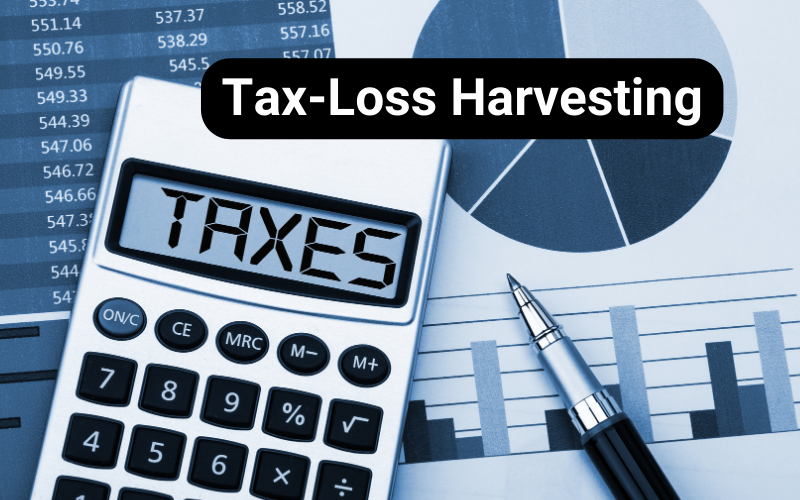Tax-Loss Harvesting: A Smart Strategy to Offset Gains
1. Introduction
What is Tax-Loss Harvesting?
Tax-loss harvesting is an investment strategy where you sell underperforming securities at a loss to offset capital gains from other investments. By strategically realizing losses, you can reduce the taxes owed on your gains or even lower your taxable income.
Why It’s Important
This strategy is especially valuable for investors who have realized significant capital gains during the year. It helps to minimize tax liability while also optimizing your investment portfolio by shedding underperforming assets.
Purpose of the Blog
This blog provides a detailed explanation of how tax-loss harvesting works, its benefits, the rules to follow, and actionable steps to implement it successfully.

2. Understanding Tax-Loss Harvesting
Definition
Tax-loss harvesting involves selling investments that have lost value to realize a capital loss. These losses can offset realized capital gains from other investments or reduce taxable income by up to $3,000 annually.
How It Works
The process includes:
- Identifying underperforming assets.
- Selling them to realize losses.
- Using these losses to offset gains or ordinary income.
Key Limits
While you can offset all your capital gains, only $3,000 in net losses can be used to reduce ordinary income each year. Any excess losses can be carried forward to future tax years.
3. Benefits of Tax-Loss Harvesting
1. Reduces Taxable Gains
Capital losses directly offset capital gains, reducing your taxable amount and the taxes owed.
2. Lowers Ordinary Income Tax
If your losses exceed your gains, up to $3,000 of those losses can be applied to reduce your ordinary income, lowering your overall tax liability.
3. Carries Forward Excess Losses
Unused losses are not wasted—they can be carried forward indefinitely to offset future gains or reduce taxable income in subsequent years.
4. Portfolio Rebalancing
Tax-loss harvesting provides an opportunity to reassess your portfolio, remove underperforming assets, and reinvest in securities that better align with your financial goals.
4. Rules and Considerations
1. Wash-Sale Rule
This rule prohibits repurchasing the same or “substantially identical” security within 30 days before or after the sale. Violating this rule disqualifies the loss for tax purposes.
2. Short-Term vs. Long-Term Losses
It’s important to match the type of loss (short-term or long-term) with the type of gain to maximize tax benefits. Short-term losses offset short-term gains, and long-term losses offset long-term gains first.
3. Recordkeeping
Accurate records of purchase dates, sale dates, and cost basis are essential for calculating and reporting your losses correctly.
5. Step-by-Step Guide to Tax-Loss Harvesting
1. Evaluate Your Portfolio
Review your investment portfolio to identify securities that have decreased in value and could be sold at a loss.
2. Match Losses with Gains
Pair your losses with gains from other investments to minimize your taxable income. Focus on high-gain assets for maximum tax impact.
3. Avoid the Wash-Sale Rule
To stay compliant, avoid repurchasing the same or similar investments within the 30-day window. Consider investing in alternatives during this period.
4. Reinvest Strategically
Use the proceeds from the sale to reinvest in different assets that align with your investment goals without triggering the wash-sale rule.
5. Record Losses for Tax Reporting
Document all transactions thoroughly and report them accurately on your tax return to claim the deductions.
6. Example of Tax-Loss Harvesting in Action
Scenario
You sell Stock A at a $10,000 loss and Stock B at an $8,000 gain.
- $8,000 of the loss offsets the $8,000 gain, eliminating taxes on the gain.
- The remaining $2,000 loss is used to reduce your taxable income.
Outcome
You save taxes on the $8,000 gain and reduce your taxable income, potentially saving hundreds or thousands of dollars in taxes.
7. Tax Implications
Limits on Deductions
- You can offset an unlimited amount of capital gains with losses.
- For ordinary income, the limit is $3,000 per year.
Capital Gains Tax Rates
- Short-term gains are taxed at your ordinary income tax rate.
- Long-term gains are taxed at lower rates (0%, 15%, or 20%), depending on your income.
Carrying Losses Forward
If your losses exceed the annual limit, the excess can be carried forward to future years indefinitely, offering ongoing tax benefits.
8. Tools and Resources for Tax-Loss Harvesting
Tax Software
- Programs like TurboTax or H&R Block can guide you through reporting capital losses and gains accurately.
Financial Advisors
- Consulting a financial advisor can help you implement tax-loss harvesting within a broader investment strategy.
Portfolio Management Platforms
- Automated platforms like Betterment and Wealthfront offer tax-loss harvesting as part of their investment management services.
9. Common Mistakes to Avoid
Triggering the Wash-Sale Rule
Accidentally repurchasing the same or a similar security within the 30-day window can disqualify your tax loss.
Overlooking Fees
Transaction fees from frequent buying and selling can diminish the financial benefits of tax-loss harvesting.
Not Reinvesting Wisely
Failing to reinvest proceeds in a well-diversified portfolio can disrupt your long-term financial goals.
10. Conclusion
Recap of Tax-Loss Harvesting
Tax-loss harvesting is a powerful strategy to reduce taxes while optimizing your investment portfolio. By selling underperforming assets and reinvesting strategically, you can save on taxes and maintain a balanced portfolio.
Encouragement to Act
Review your portfolio and identify opportunities for tax-loss harvesting before the year ends to maximize your tax benefits.
Call to Action
Consult with a tax professional or financial advisor to ensure compliance with IRS rules and to integrate tax-loss harvesting into your financial strategy effectively.


